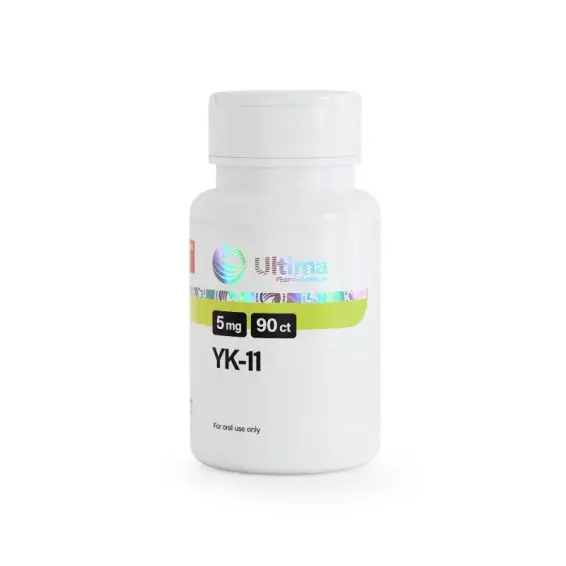- Active Substance: Myostatin
- Concentration: 5 mg/cap
- Pack Size: 90 caps
- Manufacturer: Ultima Pharmaceuticals
- Brand Name: YK11
Explore Potential Muscle Growth Beyond Limits with YK-11 5mg Capsules - A Myostatin Inhibitor & SARM
You're looking at YK-11, a synthetic steroidal selective androgen receptor modulator (SARM) that is also investigated for its unique ability to act as a myostatin inhibitor. Myostatin is a protein in the body that inhibits muscle growth. By potentially reducing myostatin levels, YK-11 is researched for its potential to promote significant muscle growth, potentially exceeding an individual's genetic predisposition.
Key Features:
- Dual Action: Acts as a SARM by selectively binding to androgen receptors and also functions as a myostatin inhibitor.
- Potential for Significant Muscle Growth: Research suggests it may promote muscle growth beyond natural limits by suppressing myostatin.
- Increased Strength: Users in research settings have reported increases in strength.
- Lean Muscle Development: Similar to other SARMs, it may promote lean muscle gains without significant water retention.
- Oral Administration: Convenient capsule form for easy dosing.
- 5 mg per Capsule: Allows for precise dosage control in research settings.
- Pack Size: 90 Capsules: Provides a substantial supply for research protocols.
- Ultima Pharmaceuticals: A manufacturer of research-grade compounds.
Mechanism of Action:
YK-11 exerts its effects through two primary mechanisms:
- Selective Androgen Receptor Modulation (SARM): It binds to androgen receptors in muscle and bone tissue, promoting anabolic effects similar to testosterone but with potentially greater selectivity, aiming to minimize androgenic side effects in other tissues.
- Myostatin Inhibition: YK-11 is believed to inhibit myostatin, a naturally occurring protein that limits muscle growth. It does this by increasing the production of follistatin, a myostatin-binding protein, thereby reducing the active myostatin available to inhibit muscle growth.
The combination of these two actions is what makes YK-11 a particularly interesting compound in research for its potential to significantly enhance muscle mass.
Potential Benefits
- Potentially Dramatic Muscle Growth: Through both androgen receptor activation and myostatin inhibition.
- Increased Strength.
- Lean Muscle Gains without Significant Water Retention.
- Potential for Bone Density Improvement (similar to other SARMs).
Use in Combination:
YK-11 is a potent research compound, and its use in combination with other substances requires careful consideration and is primarily within research settings:
- Other SARMs: Some researchers have explored combining YK-11 with other SARMs for synergistic anabolic effects, but this may also increase the risk of side effects.
- Anabolic Steroids: Combining YK-11 with anabolic steroids is a highly advanced and potentially risky area of research, aimed at maximizing muscle growth through multiple pathways.
- PCT (Post-Cycle Therapy) Compounds: Due to its potential to suppress natural testosterone production (similar to some SARMs and steroids), PCT compounds like Clomid or Nolvadex may be considered in research protocols following YK-11 use.
Possible Research Applications:
- Investigating the limits of muscle growth through dual androgen receptor activation and myostatin inhibition.
- Studies on the potential for enhanced muscle hypertrophy compared to traditional SARMs or anabolic steroids.
- Research into the long-term effects of myostatin inhibition in humans.
Usage Guidelines
YK-11 is an investigational compound and dosage guidelines are primarily based on ongoing research:
- Administration: Oral consumption via capsules.
- Dosage : Research dosages have typically ranged from 5-10 mg per day, with some studies exploring higher doses. However, optimal and safe dosages are still under investigation.
- Cycle Length : Research cycle lengths have varied, but are typically in the range of 4-8 weeks. Longer-term effects are still being studied.
- PCT (Post-Cycle Therapy) : Due to potential testosterone suppression, PCT protocols are often implemented in research settings following YK-11 administration.
Potential Side Effects:
As a relatively novel compound, the full spectrum of YK-11's side effects in humans is still under investigation. Potential side effects observed in research and anecdotal reports include:
- Testosterone Suppression: Similar to some SARMs and anabolic steroids.
- Potential Liver Toxicity: As an oral compound.
- Androgenic Side Effects: Acne, hair loss (though potentially less severe than with traditional steroids).
- Joint Pain.
- Possible Mood Changes and Increased Aggression.
- The long-term effects are largely unknown.
Important Considerations:
- Research Compound: YK-11 is primarily a research compound and its use outside of controlled research settings carries significant risks due to the limited understanding of its long-term effects and safety profile in humans.
- Regulatory Status: The legal status of YK-11 may vary significantly by region.
- Purity and Quality: When obtaining research compounds, ensuring purity and quality from reputable sources is crucial.
- Ethical Considerations: Research involving YK-11 should always adhere to ethical guidelines and regulations.
What is YK-11?
YK-11 is a synthetic steroidal SARM that also acts as a myostatin inhibitor, researched for its potential to promote significant muscle growth.
What are the potential benefits of YK-11 in research?
Potential benefits in research include significant muscle growth, increased strength, and lean muscle gains through a dual mechanism of androgen receptor activation and myostatin inhibition.
What are typical research dosages and cycle lengths for YK-11?
Research dosages have typically ranged from 5-10 mg per day for 4-8 week cycles. Optimal and safe dosages are still under investigation.
What are the potential side effects of YK-11 in research?
Potential side effects under investigation include testosterone suppression, liver toxicity, and androgenic effects. The long-term effects are largely unknown.
